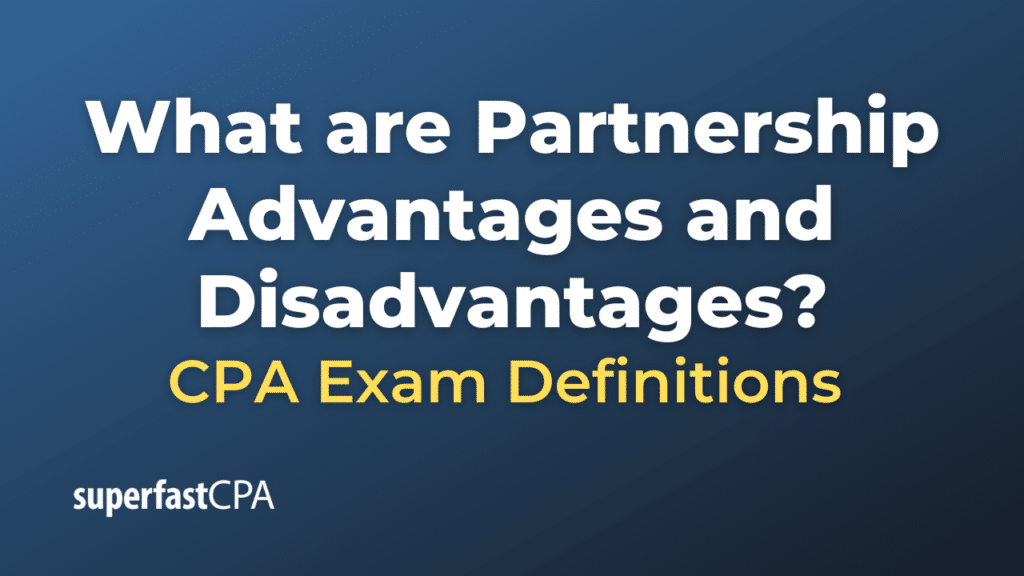Partnership Advantages and Disadvantages
Partnerships can offer several advantages but also come with certain disadvantages. Here’s a rundown of the main pros and cons:
Advantages of a Partnership:
- Easy to Form : Partnerships are generally easier and less expensive to form than corporations.
- Shared Responsibility: In a partnership, the workload, responsibilities, and risks are shared among the partners.
- Greater Financial Resources: With more than one owner, partnerships can potentially have greater access to financial resources.
- Tax Benefits: Partnerships are pass-through entities, meaning the business itself is not subject to income tax. Instead, profits or losses are passed through to the partners, who report them on their personal tax returns. This can avoid the double taxation issue faced by corporations.
- Flexibility : Partnerships offer greater flexibility in decision-making and management as compared to corporations. The partners can set the terms of the partnership agreement to suit their needs.
Disadvantages of a Partnership:
- Unlimited Liability: In a general partnership, each partner has unlimited liability for the business’s debts, meaning they could be personally responsible for the partnership’s obligations. This risk is not present in a limited partnership or limited liability partnership.
- Disagreements Among Partners: Since partnerships involve more than one person in decision-making, disagreements can occur, which can harm the functioning of the business.
- Instability: Partnerships may not be as stable as other business structures. For instance, the death or withdrawal of a partner can lead to the dissolution of the partnership unless otherwise specified in the partnership agreement.
- Difficulty in Raising Capital: While partnerships can pool resources of the partners, they might still face challenges in raising large amounts of capital compared to corporations.
- Shared Profits: The profits of a partnership must be shared among the partners, according to the terms set out in the partnership agreement.
When considering a partnership, it’s important to weigh these advantages and disadvantages, and to draft a comprehensive partnership agreement that sets out the rights and responsibilities of each partner, how profits and losses will be shared, and how disputes will be resolved. Legal and financial advice can also be helpful in making this decision.
Example of Partnership Advantages and Disadvantages
Anna and Bella decide to start a bakery together. They form a partnership because of the simplicity and ease of starting up, as well as the shared financial responsibility and capital. This shared responsibility allows them to afford a desirable location that neither could afford individually.
Advantages Experienced:
- Shared Responsibility & Financial Resources: They each specialize in different aspects of the business. Anna is a skilled baker and takes charge of the kitchen and product creation, while Bella has a knack for business and handles the financials, marketing, and customer service. The shared responsibilities allow them to focus on their strengths and run the business more efficiently.
- Tax Benefits : They also benefit from the pass-through taxation, paying taxes on their individual income tax returns based on their share of the bakery’s profits.
Disadvantages Experienced:
- Disagreements Among Partners: Over time, differences in management style arise. Bella wants to expand the business by opening more branches, while Anna prefers to focus on one shop to maintain the quality and reputation. This leads to disagreements, disrupting the smooth operation of the business.
- Unlimited Liability: Unfortunately, they signed a lease under the partnership for their bakery location. When the business goes through a rough patch and they can’t afford the rent, they learn the hard way about unlimited liability as the landlord sues them for the unpaid rent. Not only are the business assets at risk, but their personal assets are also at risk.
- Instability: After several years, Anna decides she wants to retire from the bakery business, creating uncertainty about the bakery’s future. Bella now has to decide whether to dissolve the business, buy Anna’s share, or find a new partner.
This example shows how the advantages and disadvantages of partnerships can play out in real life. While partnerships can offer significant benefits, the potential drawbacks require careful consideration and planning.













